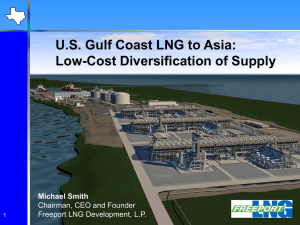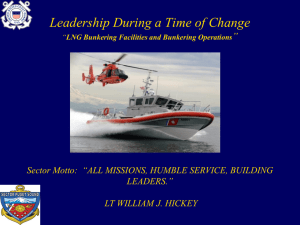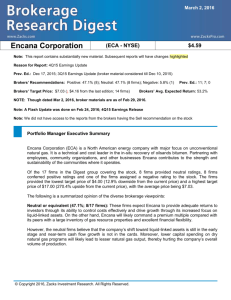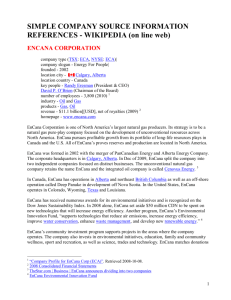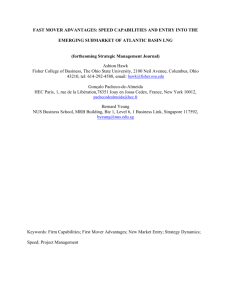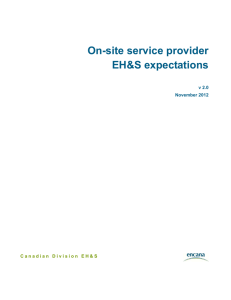Team 6: Chandler, A. D. 1992. What is a firm?
advertisement
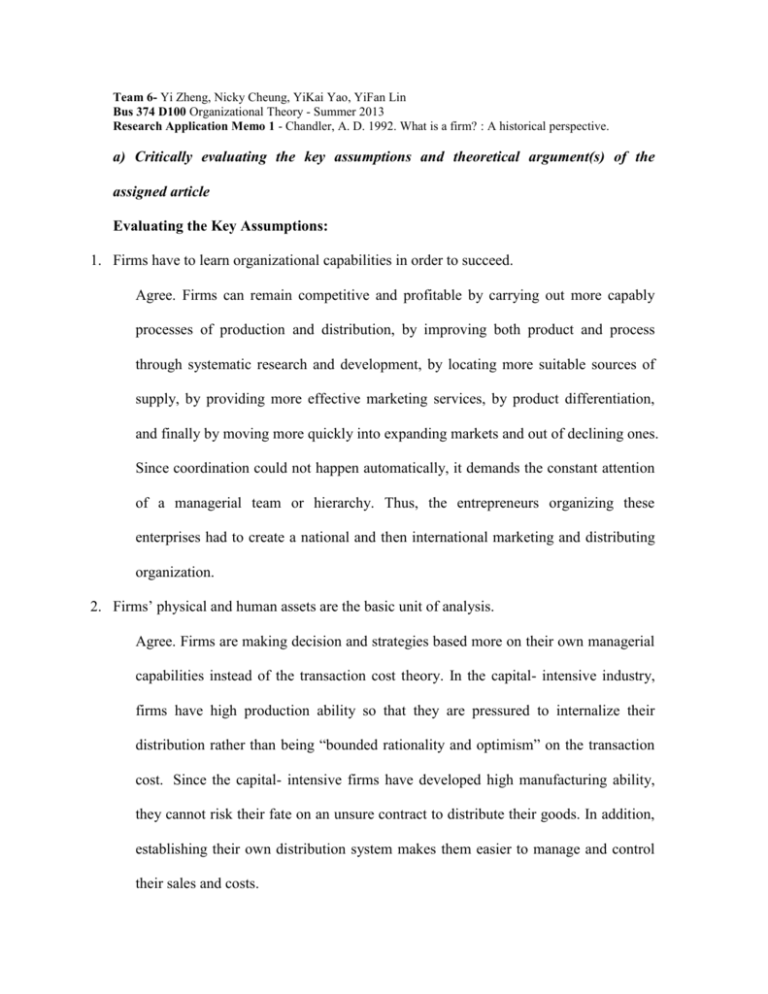
Team 6- Yi Zheng, Nicky Cheung, YiKai Yao, YiFan Lin Bus 374 D100 Organizational Theory - Summer 2013 Research Application Memo 1 - Chandler, A. D. 1992. What is a firm? : A historical perspective. a) Critically evaluating the key assumptions and theoretical argument(s) of the assigned article Evaluating the Key Assumptions: 1. Firms have to learn organizational capabilities in order to succeed. Agree. Firms can remain competitive and profitable by carrying out more capably processes of production and distribution, by improving both product and process through systematic research and development, by locating more suitable sources of supply, by providing more effective marketing services, by product differentiation, and finally by moving more quickly into expanding markets and out of declining ones. Since coordination could not happen automatically, it demands the constant attention of a managerial team or hierarchy. Thus, the entrepreneurs organizing these enterprises had to create a national and then international marketing and distributing organization. 2. Firms’ physical and human assets are the basic unit of analysis. Agree. Firms are making decision and strategies based more on their own managerial capabilities instead of the transaction cost theory. In the capital- intensive industry, firms have high production ability so that they are pressured to internalize their distribution rather than being “bounded rationality and optimism” on the transaction cost. Since the capital- intensive firms have developed high manufacturing ability, they cannot risk their fate on an unsure contract to distribute their goods. In addition, establishing their own distribution system makes them easier to manage and control their sales and costs. 3. Firm that first achieves economic scales can be competitive in the market. Disagree. IT industries may not apply to the assumption since economic scales and scope cannot compete with the speed of innovation of new technology. Even a company has economic scales and scope this year, a breakthrough innovation can turn over its advantage over night if the company fails to change and catch up the new technology. However, this assumption is still work for other industries which technology does not innovate so quickly such as traditional manufacturing industries. 4. Neoclassical Theory- Legal entity wants to maximize profits and present value of the firm. It’s impossible for managers to always act rationally for the sole benefit of the firm. There may be decision where managers have to make that put his interest at risk but may be beneficial for the company (i.e firing a friend, affecting his promotion, having competitor’s stocks, etc). Also, it doesn’t realistically explain economic growth and transformation. Managers with full information don’t mean that they can drive economic growth and transformation. 5. Principal Agent Theory- same as Neoclassical Theory but gives it a managerial hierarchy. This theory does address the same problems of the Neoclassical Theory but it still doesn’t fully explain how economic growth and transformation can be realistically derive from it. So what, if owners or shareholders manages the managers and, in turn, manage the employees? There should be more focus on the employees and what they can bring to the firm. 6. Transaction Cost Theory- transaction cost with facilities and skills results in better organizational capabilities From a cost perspective, it does show how economic growth and transformation can come about. Employees produce value but have some kind of limit because of their nature of rationality and opportunism. I can see how one can manage an organization in such a way and have some kind of economic growth and transformation. Managers will have to make sure employees have proper incentive to make them produce value and understand their personal agendas to know what information to trust. 7. Evolutionary Theory - the skills of organization. From a behavioral perspective, having good routines does help with shaping the organization’s capabilities. Learned skills can be used to take advantage of different markets and opportunities thus helping out economic growth and transformation of a firm/industry. 8. Dynamic Theory - Focuses on strategy, structure and core capabilities. Agree. Strategy shapes the structure and then affects the core capabilities of a firm. This perspective is the best because the focus tackles everyone in the company (i.e. managers, owners and employees). How the corporate environment is shape is what will dictate the attitudes and behaviors of its people. Thus, the better the working environment, the greater the firm’s organizational capabilities. b) Identifying a recent real world organizational phenomenon that either challenges or extends received wisdom (assumptions, arguments and findings) from the article Encana. The largest natural gas company in Canada with 3000 nationwide, is facing over supply of liquid natural gas (lng). A strategy the firm is implementing is to market the use of lng and lng vehicles to increase demand and decrease the gap supply and demand gap. This strategy will probably change or create parts of the firm’s organizational structure to implement this strategy. Hopefully, this will change its organizational capacity to overcome high supply of lng and benefit from economic growth. Foxconn. This company tries its best to get economic scales and scope. They carefully choose where to build their factories, how many employees need to hire and how to schedule their production process. Thus, Foxconn is growing surprisingly fast and soon became the biggest manufacturing company in electronic product industry. Though economic scales and scope cannot promise success in the business of IT industries, it still can work well in traditional manufacturing companies. Lenovo. This is a Chinese multinational technology firm. They have recently become the 5th best smart phones selling company in the world. Although they only sell 0.5 million smart phones overseas, they sell 35 million smartphones domestically. Lenovo can potentially sell more smartphones in China because they have built strong and effective distribution system. From this, we can see how important it is to internalize the distribution system. It indeed has much more potential power even exceed the author’s original theory. Apple. Apple understands the needs of the market well and works hard to meet the needs of customers. It upgrades its system frequently based on customer’s feedbacks. As advocated in the organizational capabilities, Apple does have the availability and reliability of suppliers. Apple has been constantly recruited excellent staff and managers, and insisting on providing long-lasting and high-quality training for them to ensure that its employees have excellent management communication skills c) Discussing how this real world organizational phenomenon can be used to develop novel theoretical insights relevant to the article. Lenovo’s organization phenomenon can be used to develop novel theoretical insights relevant to the article. The author argues that in the capital- intensive industry, firms have high production ability. Thus, these firms are pressured to internalize their distribution rather than being “ bounded rationality and optimism” on the transaction cost. In recent years, Lenovo launched the LePhone in order to compete against other smart phones. It tailors the prices and features of its smartphones to the preferences of Chinese consumers. Lenovo has implemented an aggressive strategy to replace Samsung as the Mainland China market's top smartphone manufacturer. Its market share increases to 14.2 percent during 2012's third quarter, representing an increase when compared to 4.8 percent in the same quarter of 2011. Lenovo's success is due to its aggressive ramping-up and improvements in channel partnerships, it possesses an obvious advantage over rivals in terms of sales channels. From Lenovo’s success, we can see that a strong and effective distribution and sales system is important which is relevant to the author’s theory about the importance of internalizing firm’s distribution system. In addition to the original theory, we can extend that firm’s distribution system should be tailored to meet specific market needs and build a long-term partnership with the distributors. The author also refers that firm’s organizational capability is essential for a company’s success, one of the capabilities is by providing more effective marketing services. Lenovo did a good marketing research and tailored its products to the preference of Chinese customers. To extend, firm’s organizational capability is essential and it should also be differentiate to apply to different markets and different customers. The oil and gas industry is facing an over-supply of Liquid Natural Gas (LNG). Encana, the largest natural gas company in Canada with 3000 employees nationwide, initiated a strategy to increase demand of LNG through creating a Natural Gas Economy Department. The goal of this is to increase demand of LNG to decrease the supply and demand gap through B2B marketing (i.e. up, mid and downstream), increasing LNG vehicle production and switching their fleet vehicles to LNG vehicles. Also, the communication and natural gas economy department of Encana collaborated with other oil and gas companies to start an awareness campaign to communicate with the public about the economical and environmental benefits of the industry using LNG. This recent real world organizational phenomenon supports the Dynamic Theory for organizations. The situation with Encana is a good example of how strategy and structural change can increase the organizational capabilities. Because the strategy is still in its implementation stage, there could probably be a increase in organizational capabilities of Encana. Perhaps by looking at this example in more in-depth, we can see that strategies are developed based on changes in the industry. In this case, an opportunity has arisen. We can see how Encana has increased its organizational capabilities individually. The theory may also apply for the industry as a whole. We may see the industry as one whole organizational unit and that everyone of them are implementing the same strategy thus may change in its structure in the same manner or even in a complementary manner ( i.e. collaborated awareness campaign). This theory should be expanding into a more macro perspective as well in situations where the industry has similar strategies.

